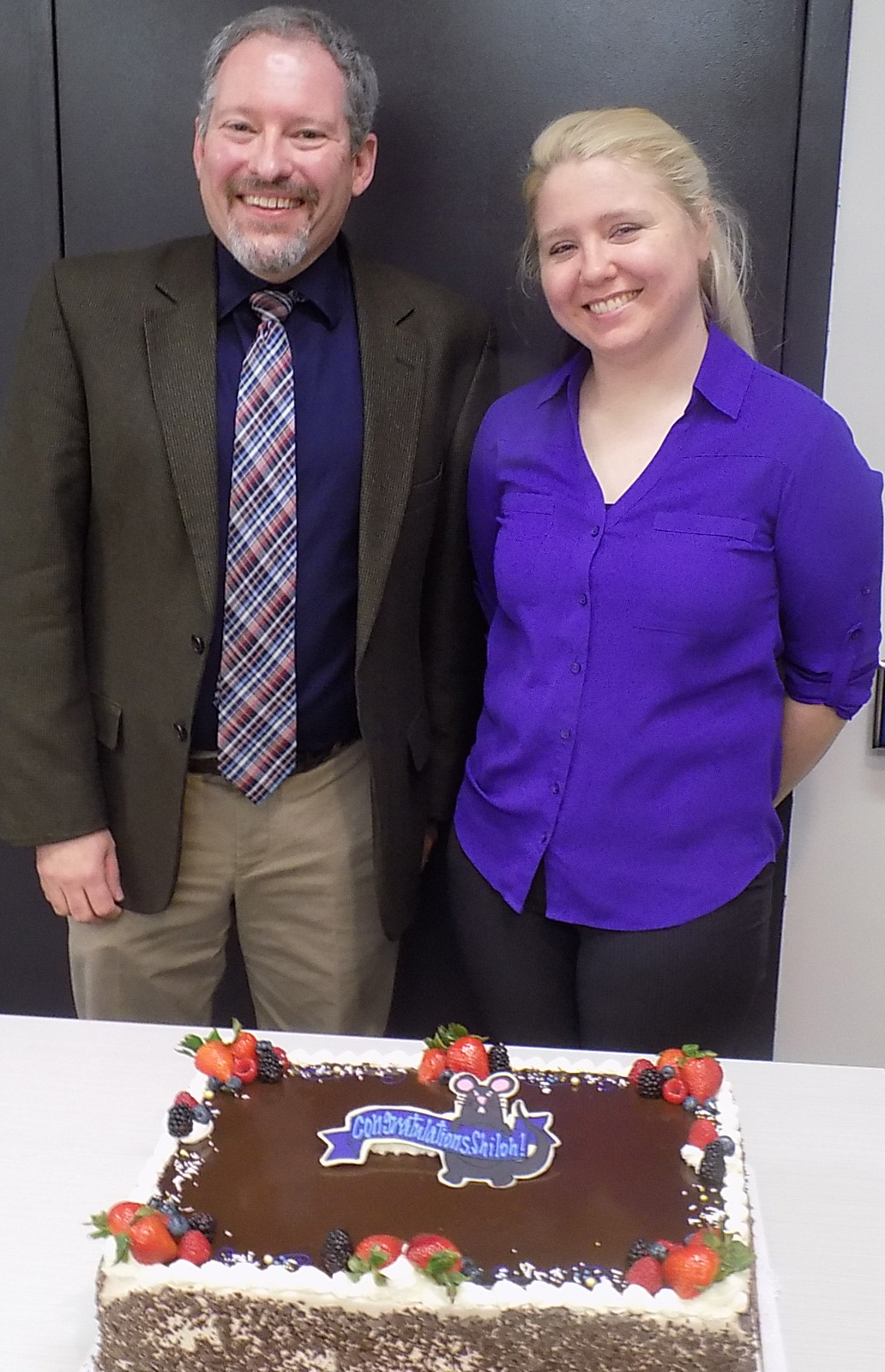 On April 5, 2022, Shiloh Lueschow successfully defended her thesis titled, "Prevention and Treatment of Neonatal Necrotizing Enterocolitis and Sepsis Using Antimicrobial Peptides and Probiotics”. She is pictured with her mentor Steven McElroy, MD.
On April 5, 2022, Shiloh Lueschow successfully defended her thesis titled, "Prevention and Treatment of Neonatal Necrotizing Enterocolitis and Sepsis Using Antimicrobial Peptides and Probiotics”. She is pictured with her mentor Steven McElroy, MD.
Background
Shiloh was born and raised in the Peoria, Illinois area as the oldest child of Kevin and Sarah Lueschow. She grew up on a farm with her two younger brothers, Jesse and Drew, raising Hampshire sheep, poultry (particularly loved ducks), pigs, donkeys, llamas, guinea pigs, cats, dogs, etc. As the daughter of an electrical engineer and a high school biology teacher, it was never a question whether she would pursue science. The question was what field to pursue. With a passion for helping people and after watching Crossing Jordan, she originally planned to study forensic science, but after watching B.D. Wong on Law and Order, her interest evolved into a desire to pursue Psychiatry.
Upon graduating high school, Shiloh pursued a Biomedical Science and Psychology double major with a double minor in Chemistry and Microbiology at Western Illinois University. There, Shiloh was also involved in undergraduate research in a Mycology/Microbial Ecology lab under the mentorship of Dr. Andrea Porras-Alfaro. Her project involved developing a better understanding of the fungal pathogen Pseudogymnoascus destructans, the causative agent of White Nose Bat Syndrome. With a new passion for research, Shiloh completed both an Honors Undergraduate Thesis and Masters on this topic.
Still thinking about pursuing a Psychiatry degree, but waiting to apply to medical school, Shiloh moved on to work at the United States Department of Agriculture (USDA) National Center for Agricultural Utilization Research (NCAUR) in Peoria, IL. Under the mentorship of Dr. Christopher Dunlap in the Crop Bio-Protection Unit (CBP), she worked on finding biological control mechanisms to manage laurel wilt and Fusarium dieback in avocado trees, nematodes in raspberry plants, and Fusarium dry rot in potatoes. Importantly, while working on these projects, she realized that she was incredibly passionate about Microbiology and decided to pursue a PhD instead of a PsyD.
In pursuit of this endeavor, Shiloh applied to the University of Iowa’s Microbiology program with the hope of finding a translational science project that would also allow her to develop bioinformatics skills. She found exactly what she was looking for with Dr. Steven McElroy. Over the past five years, she has acquired a Bioinformatics Certification and developed a better understanding of Necrotizing Enterocolitis and Neonatal Sepsis. She has also worked on potential therapeutics for these two devastating diseases, including both antimicrobial peptides and probiotics.
Outside of the lab, Shiloh primarily enjoys playing board games, video games and D&D; enjoying nature through hiking and fishing; baking; and raising Hampshire sheep. She spends time with her fiancé, Fabian, her dog, Ty, and her close family and friends.
Research
Preterm birth rates continue to rise. Preterm birth is associated with an underdevelopment of the gastrointestinal tract that results in a more permissive barrier. Preterm infants also have an immune system that functions differently from that of term infants or adults, with a hyper- or hypo- inflammatory response to stimuli and aberrant immunomodulation capabilities. Necrotizing enterocolitis (NEC) and neonatal sepsis both are diseases of mainly preterm infants due to these complications. Despite decades of research, NEC and neonatal sepsis remain difficult to predict, clinically diagnose, and treat. There is an urgent need for better prevention and treatment strategies, which fueled this research.
Using three different murine models (2 NEC models and 1 sepsis model) in P14-16 mice, our results demonstrate that the antimicrobial peptides (AMPs) LL-37 and hBD2 and probiotic strain Bifidobacterium longum subspecies infantis (B. infantis) EVC001 are effective at both preventing and treating NEC in the Paneth cell disruption with bacterial dysbiosis NEC model. One mechanism of action shared by both AMPs and B. infantis was improved epithelial wound healing. hBD2 and B. infantis were unable to prevent/treat NEC in our Paneth cell disruption with RMS formula feeding NEC model, but both were able to reduce levels of inflammatory cytokines in this model. Interestingly, while both AMPs were unable to decrease mortality in our neonatal sepsis model, B. infantis did.
Together, our work demonstrates that both AMPs and the probiotic B. infantis EVC001 show promise in the prevention and/or treatment of neonatal sepsis and NEC. Historically, prevention and treatment strategies for NEC and neonatal sepsis that show success in animal models have had mixed effects when translated to the clinic. We expect our findings to help inform future studies to understand more about the mechanisms of action for these promising prevention and treatment strategies, with the hope that they will be able to be successfully translated to improve clinical outcomes for preterm infants.